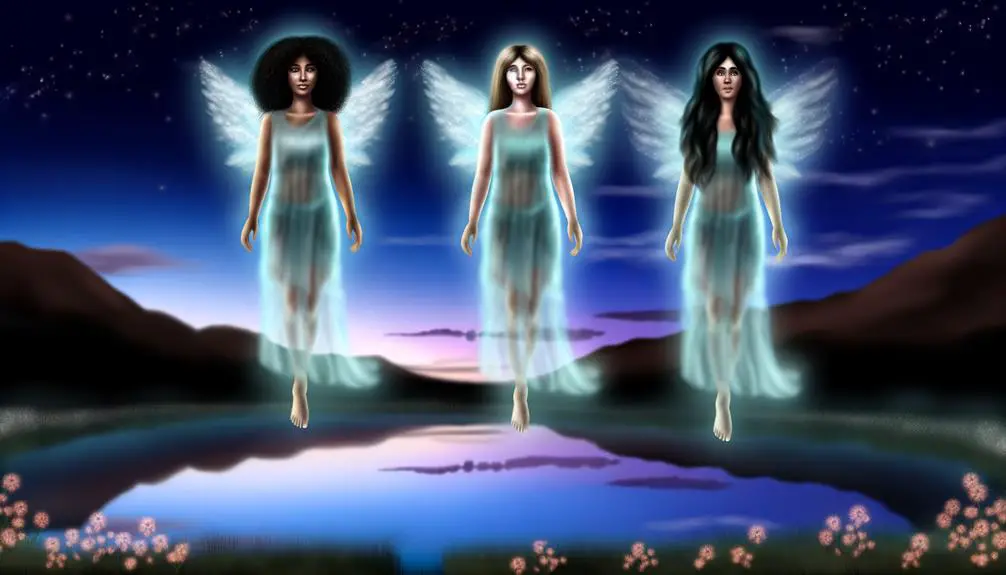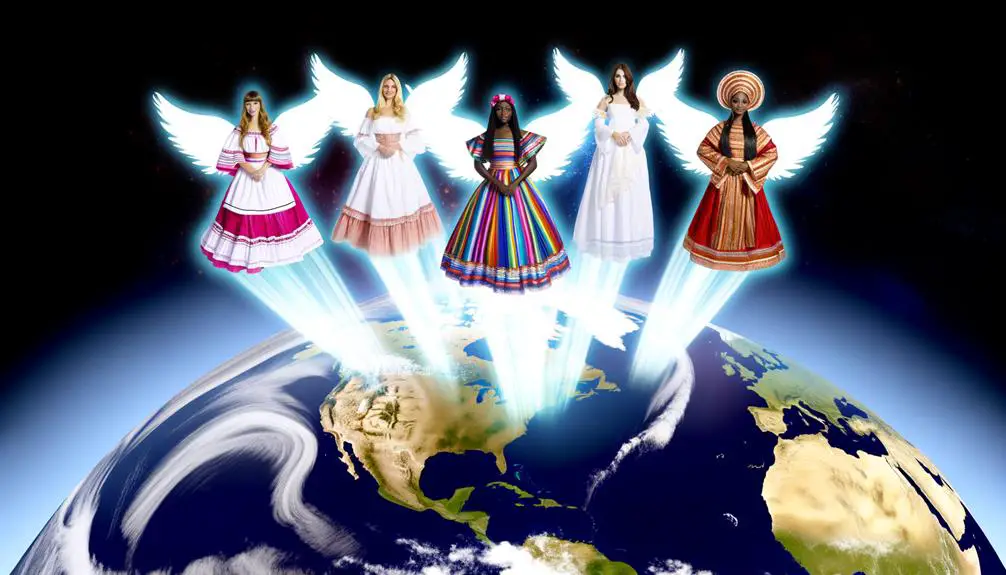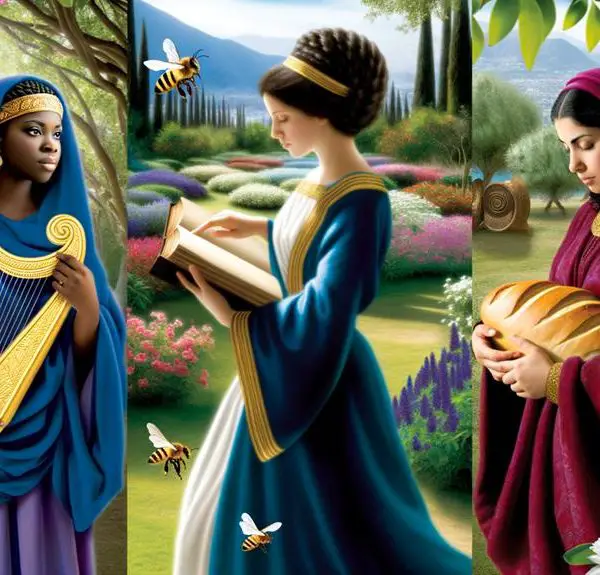Female angels in the Bible are rare and enigmatic—discover their names and the intriguing debates surrounding their existence and portrayal.

Female Angels in the Bible Names
You'll find in the Bible that references to explicitly named female angels are not commonly encountered, largely due to linguistic defaults to masculine forms in Hebrew and Greek. The use of masculine pronouns doesn't necessarily align with modern gender concepts but is shaped by broader cultural and theological ambiguity regarding angelic gender. Historical and societal biases have further skewed interpretations and translations, embedding a traditionally masculine portrayal of angels. This traditional interpretation challenges and complicates the understanding of genders in angelology. Exploring this topic unfolds layers of cultural, linguistic, and theological insights.
Key Takeaways
- The Bible does not explicitly name any angels as female in the canonical texts.
- Some apocryphal texts mention angels with feminine attributes, but these are not universally accepted.
- Gendered language in translations may imply femininity, but original texts use masculine forms.
- Cultural interpretations and translations sometimes feminize angels, reflecting societal biases rather than scriptural evidence.
- Discussions on angelic gender in theology often reflect broader debates on gender roles and identities.
Exploring Biblical Angelic Genders

When analyzing the genders of biblical angels, it is important to recognize that most scriptural references depict them using masculine pronouns, yet the Hebrew and Greek languages often default to masculine forms when gender is ambiguous or collective. This linguistic feature can lead to assumptions about the gender identity of celestial beings that may not be inherently supported by the texts themselves.
In the context of gender neutral theology, the interpretation of angelic beings in the scriptures invites a nuanced examination. Biblical pronoun usage, particularly in the original languages, does not necessarily align with gender as understood in contemporary terms. The Hebrew word for angel, 'mal'akh,' and the Greek 'angelos,' are both masculine, but their usage in scripture often serves a functional purpose rather than indicating gender.
You'll find that in many passages, the broader cultural and theological context suggests a more ambiguous approach to angelic gender. This is especially relevant when considering the angelic appearances where attributes or roles that are typically ascribed to either gender are blended or are non-specific, supporting a more inclusive interpretation. Understanding this helps in appreciating the complexity and depth of biblical texts and challenges modern preconceptions about gender roles and identities.
Named Female Angels: Evidence
While the primarily masculine depiction of angels in biblical texts, there are instances where angels with female characteristics or names appear, challenging traditional interpretations. You might find it interesting to explore these examples using a gendered language analysis. This approach examines how translations and interpretations have potentially shifted the perception of these celestial beings from a non-gendered or differently gendered essence to mostly male figures.
In the domain of scriptural authenticity debates, the few references to angels with female characteristics are often contentious. For example, Zechariah 5:9 describes two women with wings like those of a stork. These figures are not explicitly called 'angels' but are performing tasks similar to those in the angelic sphere, such as enacting divine will. Here, the original Hebrew text uses gender-specific language, which is important for an accurate understanding of the passage.
Furthermore, the interpretation of these texts often hinges on cultural contexts and the prevalence of patriarchy in biblical times, which may have influenced the gender expressions in scriptural translations. Therefore, when you're exploring these passages, it's important to take into account how historical and societal biases could have shaped the current understanding of these figures within the biblical canon.
Misinterpretations and Myths

Misinterpretations and myths have clouded our understanding of gender dynamics among biblical angels, often leading to oversimplified or erroneous interpretations. In your quest for clarity, it's essential to explore beyond surface-level readings and examine how translation errors and gender assumptions have shaped our perceptions.
- Gender Assumptions: Traditional interpretations often impose binary gender roles on angelic figures, despite the original Hebrew texts presenting angels as gender-neutral entities. This misreading influences how angels are depicted in art and literature, reinforcing stereotypical gender norms.
- Translation Errors: Key Hebrew terms like 'mal'akh' (messenger) are neutral, but are frequently translated into gendered terms in other languages. This shift can alter the perceived gender dynamics of the narrative.
- Cultural Influence: Over centuries, societal changes and evolving theological views have retroactively imposed gendered identities onto angelic beings, further distorting original scriptural intentions.
- Selective Interpretation: Some texts are highlighted or obscured based on contemporary biases, leading to a skewed understanding of angelic roles and characteristics.
As you explore these layers, you'll discover that much of what we accept as 'given' in biblical angelology is actually a complex interplay of historical contexts, translation choices, and evolving cultural norms. Keep these factors in mind to approach the texts with the nuance they require.
Angelic Names in Apocryphal Texts
As you explore angelic names in apocryphal texts, you'll find that the origins of these names often reflect broader theological themes and cultural influences. The interpretation of gender roles among these celestial beings can vary greatly, revealing much about the socio-religious contexts in which these texts were composed. Finally, examining angelic representations in artifacts allows for a nuanced understanding of how these beings were visualized and venerated in different historical periods.
Origins of Angelic Names
Throughout history, many angelic names found in apocryphal texts have origins shrouded in cultural intersections and linguistic developments. You'll find that the etymology of these names isn't just a matter of historical record but a rich tapestry that reflects varied beliefs and languages. Here's a closer look at some key aspects:
- Angel name etymology: Analyzing how names like 'Haniel' derive from Hebrew for 'Grace of God'.
- Linguistic origins analysis: Tracing languages and cultures that have influenced these names.
- Cultural intersections: Exploring how different cultures have shaped the understanding and pronunciation of these names.
- Theological implications: Studying how the meanings relate to broader religious or spiritual contexts.
Each aspect offers insights into how these angelic names have evolved over centuries.
Gender Roles: Angelic Interpretations
Building on our exploration of the origins and meanings of angelic names, we now examine how gender roles manifest in these designations within apocryphal texts. The apocrypha, often steeped in more esoteric theological implications, presents a nuanced landscape for angelic gender identity. Here, the notion of gender fluidity emerges more prominently, challenging traditional binary gender roles seen in mainstream biblical texts. This fluidity isn't merely a cultural artifact but serves as a theological statement about the nature of divine beings—transcending human gender constructs to embody a more holistic form of existence. These interpretations encourage you to rethink conventional views and acknowledge the complexities introduced by these spiritual entities within sacred narratives.
Angelic Representations in Artifacts
Delving deeper into angelic names within apocryphal texts reveals their varied representations in ancient artifacts, illuminating how these texts influenced artistic and religious expression. The intricacies of these representations often require advanced dating techniques to understand their chronological context and significance in religious history.
- Artifact Preservation: Ensuring the longevity of these cultural pieces for future analysis.
- Dating Techniques: Utilizing methods like radiocarbon dating to ascertain the age of artifacts.
- Symbolic Detailing: Analysis of how angelic imagery varies across different cultures and periods.
- Textual Correlation: Connecting the depiction of angels in artifacts with their descriptions in apocryphal texts.
This scholarly approach helps us appreciate the depth of angelic iconography and its evolution over time.
Scholarly Perspectives on Gender
Exploring the concept of gender in biblical texts reveals that traditional interpretations often reflect the cultural biases of their times rather than explicit scriptural mandates. You'll find that gender linguistics play a vital role in understanding these biases, especially as languages evolve in their expressions and usage over centuries. For instance, Hebrew, the original language of much of the Bible, contains gendered nouns; yet, the application of gender in translations can be influenced by the societal norms of translators rather than strict adherence to original meanings.
Feminist theology has been instrumental in reevaluating these interpretations, advocating for a more nuanced reading of biblical texts. Scholars within this field argue that many references to angelic beings as exclusively male derive not from definitive textual evidence but from patriarchal interpretations that overlook or marginalize female spiritual entities. They push for a reconsideration of how angelic gender is portrayed, suggesting that such beings could transcend human gender binaries altogether. This perspective encourages you to question how much of our understanding of biblical gender roles is colored by later human interpretations, rather than anything inherently prescribed within the scripture itself.
Cultural Impact of Angelic Beings

As you explore the cultural impact of angelic beings, consider how religious artistic representations have shaped perceptions of gender among these celestial figures. Assess the tension between mythology and theology in understanding their roles and identities across different cultures. Reflect on how modern media portrayals continue to influence and reshape these ancient symbols in contemporary society.
Religious Artistic Representations
Throughout history, religious art has powerfully depicted angelic beings, profoundly influencing cultural perceptions and spiritual imaginations across various societies. You've seen the artistic symbolism and iconographic evolution of these depictions change, reflecting various theological and cultural shifts.
- Artistic Symbolism: Each brushstroke and color choice in angelic imagery carries deep symbolic meaning, often reflecting purity, divine intervention, and spiritual guidance.
- Iconographic Evolution: From the ethereal figures in Byzantine mosaics to the dynamic angels in Renaissance paintings, artistic representations of angels have evolved dramatically, showcasing changes in religious thought and artistic style.
- Cultural Impact: Angelic images have permeated various cultures, influencing literature, music, and even fashion.
- Spiritual Imaginations: These representations help shape individual and collective notions of spirituality and the divine, making abstract concepts more tangible and relatable.
Mythology Versus Theology
When exploring the cultural impact of angelic beings, it is crucial to differentiate between their mythological representations and theological significance. Mythology often embellishes these entities with various attributes and roles that may not align with theological doctrines. You will notice that discussions on gender identity arise frequently in mythological contexts, where angels are depicted with different gender traits, reflecting broader cultural narratives about gender fluidity and roles. However, in theological debates, the accuracy of such portrayals is often challenged. Scholars and believers alike examine scriptural texts to argue the fidelity of angelic gender depictions to original religious teachings. This conversation not only shapes your comprehension of angelic beings but also influences wider theological and cultural discussions on gender and divinity.
Modern Media Portrayals
Modern media portrayals of angelic beings often reflect contemporary societal values and tensions, illustrating how these celestial figures are adapted to resonate with current audiences. You'll find that the cultural impact is deeply embedded in both cinematic adaptations and television series analysis.
- Cinematic Adaptations: Films often depict angels as messengers or warriors, subtly addressing themes of morality vs. amorality.
- Television Series Analysis: TV shows frequently explore the intricacies of angels dealing with human dilemmas, highlighting conflicts between divine duties and personal desires.
- Character Complexity: Modern angels in media are portrayed with deeper emotional and ethical complexities.
- Audience Resonance: These portrayals connect with contemporary issues, making celestial narratives relevant and engaging for today's viewers.
This approach ensures that angelic beings remain not only spiritually significant but also culturally and socially relevant.
Frequently Asked Questions
How Do Angels Communicate With Humans in the Bible?
In the Bible, angels often communicate with humans through dream interpretations and prophetic visions, providing guidance or divine messages. These encounters are depicted as profound, sometimes requiring deep reflection to understand their significance.
Are There Any Female Angels Mentioned in Prayers?
You'll find that traditional prayer formulations don't typically specify angelic genders, focusing more on their roles. Angelic invocations in prayers seldom mention specific names, making the identification of female angels particularly challenging.
What Roles Do Female Angels Play in Biblical Stories?
In biblical narratives, angels typically serve as divine messengers, yet gender interpretations vary. You'll find that explicit roles for female angels aren't clearly defined, reflecting broader ambiguities in scriptural angelology.
Do Female Angels Appear in Modern Religious Ceremonies?
In modern religious ceremonies, you might notice fewer references to female angels, reflecting traditional gender perceptions about ceremonial roles. This trend highlights the broader cultural reluctance to depict angels in a gender-specific manner.
How Are Female Angels Depicted in Religious Art?
In religious art, you'll often see female angels depicted as serene as a summer lake, embodying artistic symbolism and nuanced gender representation, reflecting both historical contexts and evolving interpretations of spirituality and divinity.



Sign up